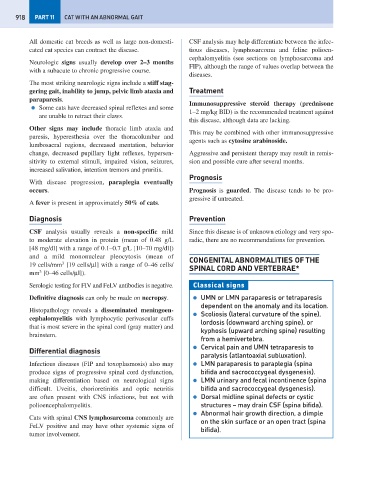Page 926 - Problem-Based Feline Medicine
P. 926
918 PART 11 CAT WITH AN ABNORMAL GAIT
All domestic cat breeds as well as large non-domesti- CSF analysis may help differentiate between the infec-
cated cat species can contract the disease. tious diseases, lymphosarcoma and feline polioen-
cephalomyelitis (see sections on lymphosarcoma and
Neurologic signs usually develop over 2–3 months
FIP), although the range of values overlap between the
with a subacute to chronic progressive course.
diseases.
The most striking neurologic signs include a stiff stag-
gering gait, inability to jump, pelvic limb ataxia and Treatment
paraparesis.
Immunosuppressive steroid therapy (prednisone
● Some cats have decreased spinal reflexes and some
1–2 mg/kg BID) is the recommended treatment against
are unable to retract their claws.
this disease, although data are lacking.
Other signs may include thoracic limb ataxia and
This may be combined with other immunosuppressive
paresis, hyperesthesia over the thoracolumbar and
agents such as cytosine arabinoside.
lumbosacral regions, decreased mentation, behavior
change, decreased pupillary light reflexes, hypersen- Aggressive and persistent therapy may result in remis-
sitivity to external stimuli, impaired vision, seizures, sion and possible cure after several months.
increased salivation, intention tremors and pruritis.
Prognosis
With disease progression, paraplegia eventually
occurs. Prognosis is guarded. The disease tends to be pro-
gressive if untreated.
A fever is present in approximately 50% of cats.
Diagnosis Prevention
CSF analysis usually reveals a non-specific mild Since this disease is of unknown etiology and very spo-
to moderate elevation in protein (mean of 0.48 g/L radic, there are no recommendations for prevention.
[48 mg/dl] with a range of 0.1–0.7 g/L [10–70 mg/dl])
and a mild mononuclear pleocytosis (mean of
CONGENITAL ABNORMALITIES OF THE
3
19 cells/mm [19 cells/μl] with a range of 0–46 cells/
SPINAL CORD AND VERTEBRAE*
3
mm [0–46 cells/μl]).
Serologic testing for FIV and FeLV antibodies is negative. Classical signs
Definitive diagnosis can only be made on necropsy. ● UMN or LMN paraparesis or tetraparesis
dependent on the anomaly and its location.
Histopathology reveals a disseminated meningoen-
● Scoliosis (lateral curvature of the spine),
cephalomyelitis with lymphocytic perivascular cuffs
lordosis (downward arching spine), or
that is most severe in the spinal cord (gray matter) and
kyphosis (upward arching spine) resulting
brainstem.
from a hemivertebra.
● Cervical pain and UMN tetraparesis to
Differential diagnosis
paralysis (atlantoaxial subluxation).
Infectious diseases (FIP and toxoplasmosis) also may ● LMN paraparesis to paraplegia (spina
produce signs of progressive spinal cord dysfunction, bifida and sacrococcygeal dysgenesis).
making differentiation based on neurological signs ● LMN urinary and fecal incontinence (spina
difficult. Uveitis, chorioretinitis and optic neuritis bifida and sacrococcygeal dysgenesis).
are often present with CNS infections, but not with ● Dorsal midline spinal defects or cystic
polioencephalomyelitis. structures – may drain CSF (spina bifida).
● Abnormal hair growth direction, a dimple
Cats with spinal CNS lymphosarcoma commonly are
on the skin surface or an open tract (spina
FeLV positive and may have other systemic signs of
bifida).
tumor involvement.

